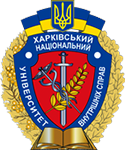Distinguishing collaboration from related elements of crime
Abstract
The article is devoted to the distinction between the corpus delicti of crimes under Article 111-1 of the Criminal Code of Ukraine “Collaboration” and related crimes. Scientific articles by researchers who studied who have studied the objective and subjective features of collaboration have been analysed. It is stated that collaboration differs from high treason by the nature of the acts constituting the objective element of the crime, the time of the crime and the subject of the crime. The collaboration is distinguished from aiding and abetting the aggressor State by the subject of collaboration.The set of actions that make up the objective side of the specified crimes also has differences. The difference between the creation of illegal paramilitary formations and collaborative activities lies in the object of the crime. In addition, the crime provided for in Part 7 of Article 111-1 of the Criminal Code of Ukraine is committed in the conditions of the Ukrainian territory occupation as a result of the invasion of the aggressor state troops. The collaborative activity must be distinguished from the crime provided for in Article 436-2 of the Criminal Code of Ukraine “Justification, recognition as legitimate, denial of the armed aggression of the russian federation against Ukraine, glorification of its participants”. The differences are in the object of the crime. In addition, collaboration can only be carried out in the occupied territory.It is proposed to make changes to the Criminal Code of Ukraine. In particular, it is proposed to define the concept of subversive activity, which is used in Article 111 of the Criminal Code of Ukraine. It is necessary to specify the list of actions that can be considered as assisting the enemy in subversive activities. Establish clear distinctions between collaborative activities and assisting the enemy in subversive activities. It is necessary to solve other problematic issues of qualification of violations of the legislation of Ukraine under Article 111-1 of the Criminal Code of Ukraine or other articles of the Code containing similar offenses.
Downloads
References
Chaltseva, O. S. (2022). Category “Collaborationism” as a Multicomponent Narrative in Wartime. Political Life, 2, 56–60. https://doi.org/10.31558/2519-2949.2022.2.9.
Yanishevska, K. D., & Krysko, A. S. (2022). General theoretical aspects and classification of collaborative activity as a criminal phenomenon. National Technical University of Ukraine Journal. Political Science. Sociology. Law, 4(56), 71–76. https://doi.org/10.20535/2308-5053.2022.4(56).269622.
Popovych, O. V. (2022, June 17). Collaborative activity: criminalization of a socially dangerous act or differentiation of criminal liability for treason [Conference presentation abstract]. International Scientific and Practical Conference “The European choice of Ukraine, the development of science and national security in the realities of large-scale military aggression and global challenges of the XXI century (to the 25th anniversary of the Odesa Law Academy National University and the 175th anniversary of the Odessa Law School)”, Odesa Ukraine.
Vasylenko, Yu. V. (2022). Collaborative activity: criminal characteristics of the offense. Journal of Kyiv Institute of Intellectual Property and Law, 1, 3–8. https://doi.org/10.32782/chasopyskiivp/2022-1-1.
Kravchuk, O. O., & Bondarenko, M. S. (2022). Collaborative activities: scientific and practical commentary on the new article 111-1 of the Criminal Code. Juridical Scientific and Electronic Journal, 3, 198–204. https://doi.org/10.32782/2524-0374/2022-3/45.
Kuznetsov, V. V., & Siiploki, M. V. (2022). Criminal liability for collaboration as a new challenge today. Uzhhorod National University Herald. Series: Law, 70, 381–388. https://doi.org/10.24144/2307-3322.2022.70.61.
Symonenko, N. O. (2022). Criminal law novel about collaboration activity. Herald of the Association of Criminal Law of Ukraine, 1(17), 92–109. https://doi.org/10.21564/2311-9640.2022.17.257848.
Holinka, M. I. (2023). Article 111-1 of the Criminal Code of Ukraine (collaborative activity) and related phenomena: problems of legislative regulation. Scientific notes of the Lviv University of Business and Law, 36, 251–258. https://doi.org/10.5281/zenodo.7807937.
Copyright (c) 2023 O. V. Pletnov, Ye. V. Kovalenko

This work is licensed under a Creative Commons Attribution 4.0 International License.



